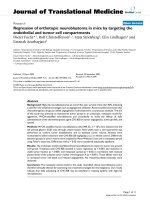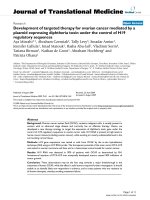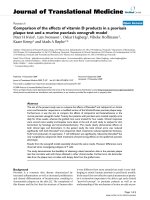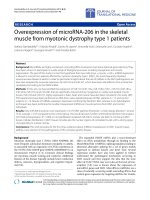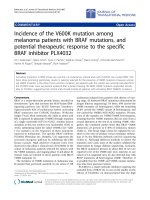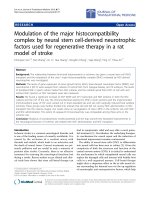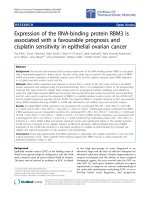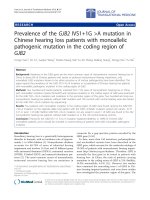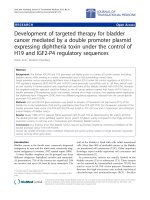báo cáo hóa học: " Responsiveness of the EQ-5D in breast cancer patients in their first year after treatment" ppt
Bạn đang xem bản rút gọn của tài liệu. Xem và tải ngay bản đầy đủ của tài liệu tại đây (238.57 KB, 7 trang )
BioMed Central
Page 1 of 7
(page number not for citation purposes)
Health and Quality of Life Outcomes
Open Access
Research
Responsiveness of the EQ-5D in breast cancer patients in their first
year after treatment
Merel L Kimman*
1,2
, Carmen D Dirksen
3
, Philippe Lambin
1,2
and
Liesbeth J Boersma
1,2
Address:
1
MAASTRO Clinic, School for Oncology and Developmental Biology (GROW), Maastricht University Medical Centre, Maastricht, the
Netherlands,
2
Department of Radiation Oncology (MAASTRO), Maastricht University Medical Centre, Maastricht, the Netherlands and
3
Department of Clinical Epidemiology and Medical Technology Assessment, Maastricht University Medical Centre, Maastricht, the Netherlands
Email: Merel L Kimman* - ; Carmen D Dirksen - ;
Philippe Lambin - ; Liesbeth J Boersma -
* Corresponding author
Abstract
Background/aim: The EQ-5D is a generic health-related quality of life (HRQoL) measure that is
used for the purpose of economic evaluations of health interventions. Therefore, it has to be
responsive to meaningful changes in health in the patient population under investigation. The aim
of this study was to investigate the responsiveness of the EQ-5D in breast cancer patients in their
first year after treatment.
Methods: The subscale global health of the disease-specific HRQoL measure EORTC QLQ-C30
was used as a reference instrument to determine meaningful changes in health and identify
subgroups of patients: patients reporting a moderate-large deterioration, small deterioration, a
small improvement, moderate-large improvement, or no change in health status. Responsiveness
was evaluated by calculating standardized response means (SRMs) in the five subgroups of patients
and performing analysis of variance procedures. The two HRQoL measures were filled out two
weeks and one year after finalizing curative treatment for breast cancer (n = 192).
Results: The EQ-5D was able to capture both improvements and deteriorations in HRQoL. SRMs
of the EQ VAS and EQ-5D Index were close to zero in the subgroup reporting no change and
increased and decreased adequately in the subgroups reporting small and moderate changes.
Additional analysis of variance procedures showed that the EQ-5D was able to differentiate
between subgroups of patients with no change and moderate-large deterioration or improvement
in health.
Conclusion: The EQ-5D seems an appropriate measure for the purpose of economic evaluations
of health intervention in breast cancer patients after treatment.
Trial registration: Current Controlled Trials ISRCTN74071417.
Published: 7 February 2009
Health and Quality of Life Outcomes 2009, 7:11 doi:10.1186/1477-7525-7-11
Received: 4 November 2008
Accepted: 7 February 2009
This article is available from: />© 2009 Kimman et al; licensee BioMed Central Ltd.
This is an Open Access article distributed under the terms of the Creative Commons Attribution License ( />),
which permits unrestricted use, distribution, and reproduction in any medium, provided the original work is properly cited.
Health and Quality of Life Outcomes 2009, 7:11 />Page 2 of 7
(page number not for citation purposes)
Introduction
With an estimated 1.15 million new cases worldwide each
year and a relatively good prognosis, breast cancer is the
most prevalent cancer in the world today [1]. After cura-
tive treatment for breast cancer, women attend frequent
follow-up visits to be examined for possible local or
regional recurrence or a second primary breast tumor, and
to receive psychosocial support [2,3]. However, no strong
evidence exists that regular follow-up is effective with
regard to disease free survival or overall survival [4-6], or
in providing psychosocial support [7,8]. Hence, the
assessment of outcomes like patient satisfaction and
health-related quality of life (HRQoL) is common practice
in clinical oncology trials investigating alternative follow-
up strategies and psychosocial interventions for breast
cancer survivors [9-18]. Given the high prevalence of
breast cancer and budget constraints in health care, it is
also important to understand the impact of alternative
strategies on economic outcomes. Therefore, clinical trials
are increasingly incorporating generic HRQoL measures,
such as the EQ-5D, for the purpose of economic evalua-
tions [19]. The EQ-5D is a standardized multi-dimen-
sional health state classification system. It generates a
single index score for each health state [20]. Index scores,
in turn, can be used to calculate quality adjusted life years
(QALYs), which is the most preferred summary outcome
measure in economic evaluations [21].
A substantial and growing body of literature regarding the
usefulness of the EQ-5D in cancer has emerged, support-
ing its validity and reliability [19]. However, the respon-
siveness of the EQ-5D, defined as its ability to capture true
underlying changes in the patients' health status over time
[22], is highly dependent on patient population and set-
ting. In comparison with disease-specific instruments, the
responsiveness of the EQ-5D was found to be comparable
in one study [23], but more often it is found to be less
responsive than disease-specific instruments [24-27].
Hence, the usefulness of the EQ-5D may be limited if it is
not able to detect changes in health status in the patient
population under investigation.
To our knowledge, the responsiveness of the EQ-5D has
not yet been examined in breast cancer patients after treat-
ment. Therefore, we use data from a randomized clinical
trial investigating several follow-up strategies for cura-
tively treated breast cancer patients [10] to address
whether the EQ-5D is responsive to changes in HRQoL in
a population of breast cancer patients in their first year
after treatment.
Methodology
Study population
Participants were enrolled in a randomized clinical trial
investigating the cost-effectiveness of nurse-led telephone
follow-up and a short educational group program after
curative treatment for breast cancer (MaCare trial, ISRCTN
74071417) [10]. Patients in the trial were all female,
treated for breast cancer with curative intent, and had no
concomitant tumors or comorbidity requiring hospital
visits. There were no age restrictions. Patients were
included in the trial after finalizing treatment and after
giving written informed consent. Treatment included sur-
gery and/or radiotherapy and/or chemotherapy. Follow-
up appointments took place at three, six, nine and twelve
months after treatment. For the purpose of studying the
responsiveness of the EQ-5D, patients who had had their
twelve months follow-up were eligible. The EQ-5D and
the disease-specific EORTC QLQ-C30 were sent to
patients at home two weeks after the end of treatment
(T0) and twelve months after treatment (T1). Of 220 eli-
gible patients, 29 patients failed to complete both instru-
ments at both measurements due to either random
missings within the instruments (n = 19) or because they
were a study drop-out (n = 10). A total of 192 patients
were therefore included in the analysis. Their demo-
graphic and clinical characteristics can be found in table 1.
Patients were analyzed regardless of follow-up strategy in
the trial.
The MaCare trial was approved by the Independent Ethics
Committee of MAASTRO Clinic.
HRQoL Instruments
EQ-5D
The EQ-5D is a short generic health-related quality of life
instrument that consists of two parts: a self-classifier and
a Visual Analogue Scale (EQ VAS). The self-classifier com-
prises five items relating to problems in the following
domains: mobility, self-care, usual activities, pain/dis-
comfort and anxiety/depression [20]. Each domain has
three levels, namely, "no problems", "some problems"
and "severe problems". Combinations of these categories
define a total of 243 health states. Dolan et al [28] have
presented 42 of these health states to approximately 3000
members of a representative sample of the UK general
population, which were valued using the time-trade-off
(TTO) technique. Based on these valuations, for each
health state a utility score can be deducted, called the EQ-
5D Index score. These EQ-5D Index scores may vary
between -0.59 (worst health) and 1.00 (perfect health).
On the EQ VAS respondents can indicate their overall self-
perceived health state on a scale ranging from 0 to 100,
where 0 is equivalent to the worst imaginable health state
and 100 is equivalent to the best imaginable health state.
EORTC QLQ-C30
The EORTC QLQ-C30 from the European Organization
for Research and Treatment of Cancer is a self-adminis-
tered disease-specific HRQoL questionnaire and is vali-
Health and Quality of Life Outcomes 2009, 7:11 />Page 3 of 7
(page number not for citation purposes)
dated for oncology clinical research [29-31]. It has also
been validated [32] and found to be responsive [33] spe-
cifically in breast cancer patients and is widely used in
breast cancer research investigating HRQoL after treat-
ment [34-40]. The HRQoL questionnaire consists of 30
items. After transformation, the EORTC QLQ-C30 has
several multi-item functional subscales (e.g. physical,
emotional functioning), multi-item symptom scales (e.g.
fatigue, pain), a global health subscale, and single items to
assess symptoms (e.g. sleep disturbance). Scores on the
functional and global health scales range from 0 to 100,
where a higher scale score represents a higher level of
functioning and therefore HRQoL.
Analyses of responsiveness
To assess the responsiveness of the EQ-5D three steps
were taken, following recommendations recently pub-
lished by Revicki et al (2008). First, a criterion, or anchor,
that is related to the measure under investigation, was
selected to identify whether patients had changed (either
improved or worsened) over time. Second, when the rela-
tionship between the anchor and EQ-5D was confirmed,
patients were classified into subgroups according to
changes in their health status. Third, to examine respon-
siveness, statistical indicators for change were calculated
and analysis of variance procedures were performed.
Step 1: Selecting an anchor; global health of the EORTC QLQ-C30
Selecting anchors should be based on criteria of relevance
for the disease indication, clinical acceptance and validity,
and evidence that the anchors have some relationship
with the measure under investigation [41]. For this study,
the subscale global health of the EORTC QLQ-C30 was
proposed as a criterion for clinical change. The global
health subscale consists of two items: (1) How would you
rate your physical condition during the past week? and;
(2) How would you rate your overall quality of life during
the past week?
Correlations between global health scores and the EQ-5D
Index and EQ VAS were calculated to examine whether the
anchor was acceptable [41]. It is recommended that 0.30–
0.35 is used as a correlation threshold to define acceptable
association between an anchor and a change score on the
HRQoL outcome measure [41].
Step 2: Classifying patients into subgroups
Change scores on global health of the EORTC QLQ-C30
were used to identify subgroups of patients. In an analysis
of the clinical significance of changes in HRQoL, Osoba et
al (1994) showed that patients judge a change between 5–
10 on the global health scale of the EORTC QLQ-C30 to
be small, between 10–20 to be moderate, and more than
20 to be large [33,42]. Consequently, a change smaller
than 5 points was considered to be no change. Taking into
account both deteriorations and improvements, this
results in a maximum of 7 subgroups.
Step 3: Examining responsiveness
Responsiveness to change was evaluated using a statistical
indicator, the standardized response mean (SRM). The
SRM is the change in score divided by the standard devia-
tion of the change in score. It is independent of sample
size and widely used today [43]. SRMs were calculated for
the EQ-5D Index and EQ VAS, for all subgroups of
patients. Scores were interpreted using benchmarks for
effect sizes: 0.20 through 0.49 was interpreted as small,
0.50 through 0.79 as moderate and ≥ 0.80 as large [44].
Table 1: Characteristics of participants (n = 192)
Characteristic Descriptive statistic
Age
Mean (SD) 55.8 (10.1) yrs
Range 23–79 yrs
Level of education
Low 69 (35.9%)
Middle 96 (50.0%)
High 27 (14.1%)
Tumor stage
Stage I 99 (51.6%)
Stage II 61 (31.8%)
Stage III 17 (8.6%)
Unknown 15 (7.8%)
Treatment modality
Surgery 17 (8.9%)
Surgery and radiotherapy 107 (55.7%)
Surgery and chemotherapy 13 (6.8%)
Surgery and radiotherapy and chemotherapy 55 (28.6%)
Hormonal therapy 65 (34%)
Health and Quality of Life Outcomes 2009, 7:11 />Page 4 of 7
(page number not for citation purposes)
Additionally, analysis of variance, with Games Howell
post hoc procedures, was performed to compare the mean
change scores on the EQ-5D Index and EQ VAS between
the 'no change' subgroup and the other subgroups identi-
fied in step 2.
Results
Step 1. Selecting an anchor
The global health scale of the EORTC QLQ-C30 correlated
to the change scores of the EQ-5D Index and EQ VAS (r =
0.423 and r = 0.634 respectively). Hence, global health
was found to be an appropriate anchor and was used to
classify subgroups.
Step 2. Classifying patients into subgroups
After twelve months, 6 patients (3%) reported a large
deterioration on global health, 17 (9%) reported a mod-
erate deterioration, 14 (7%) reported a small deteriora-
tion, 55 (28%) reported no change, 28 (16%) reported a
small improvement, 32 (17%) a moderate improvement
and 40 (21%) reported a large improvement on global
health.
Due to a relatively small number of patients reporting a
moderate or large deterioration, it was decided to create
one subgroup for patients with both moderate and large
deteriorations ('moderate-large deterioration') and, for
easy comparison, also one subgroup for both moderate
and large improvements ('moderate-large improvement').
Hence, five subgroups were identified, classifying patients
reporting a (1) moderate-large deterioration (n = 23), (2)
small deterioration (n = 14), (3) no change (n = 55), (4)
a small improvement (n = 28) and (5) moderate-large
improvement in health status (n = 72).
Step 3. Examining responsiveness
Mean baseline scores, scores at the twelve month meas-
urement and change scores are presented for all HRQoL
measures in table 2. The EQ VAS and EQ-5D Index both
moved in the expected direction, indicating negative
changes (deterioration) in the subgroups reporting deteri-
oration on global health of the EORTC QLQ-C30 and
positive changes (improvements) in the subgroups
reporting improvements on global health. Accordingly,
only a minor change on the EQ VAS and no change on the
EQ-5D Index were reported in the no change subgroup of
the EORTC QLQ-C30.
To examine responsiveness, SRMs were calculated for the
EQ-5D Index and EQ VAS (table 2). In the subgroup of
patients whose global health had not changed, accord-
ingly, neither the SRM of the EQ-5D Index, nor of the EQ
VAS indicated an effect. SRMs of the EQ-5D Index for the
subgroups indicating a small deterioration or small
improvement were too small (i.e. SRM < 0.20) to be con-
sidered as an effect. In contrast, SRMs of the EQ VAS indi-
cated a small effect in these subgroups. SRMs of the
subgroups with moderate and large improvements or
deteriorations in global health indicated a moderate effect
on the EQ-5D Index (i.e. SRM > 0.50) and a large effect on
the EQ VAS (i.e. SRM > 0.80).
Analysis of variance procedures were performed to evalu-
ate whether the EQ-5D could discriminate between the
five subgroups (table 3). Results indicated that when the
EQ-5D Index score was used as the outcome measure, the
subgroup reporting no change on global health differed
significantly from the subgroup reporting moderate and
large improvements. The subgroups reporting small
improvements or a small or moderate and large deteriora-
Table 2: Baseline scores (T0), twelve months scores (T1) and mean change scores with standard deviations.
EORTC QLQ-C30 global health EQ VAS EQ 5D Index
Subgroup T0 T1 Δ (sd) T0 T1 Δ (sd) SRM T0 T1 Δ (sd) SRM
Moderate-large deterioration
(n = 23)
79.3 56.9 -22.5
(10.8)
73.0 59.8 -13.2
(11.2)
-1.17 0.72 0.57 -0.15
(0.29)
-0.52
Small deterioration
(n = 14)
75.6 67.3 -8.3
(0.0)
74.4 69.4 -5.1
(12.0)
-0.42 0.73 0.72 -0.01
(0.18)
-0.05
No change
(n = 55)
80.9 80.9 0.0
(0.0)
79.0 79.9 0.7
(8.8)
0.08 0.82 0.82 0.00
(0.21)
0.01
Small improvement
(n = 28)
71.2 80.1 8.3
(0.0)
70.9 77.7 6.1
(7.7)
0.79 0.78 0.80 0.02
(0.14)
0.16
Moderate-large improvement
(n = 72)
58.2 85.6 27.4
(11.9)
65.0 77.4 12.1
(12.7)
0.95 0.71 0.83 0.13
(0.20)
0.62
SRMs of the EQ VAS and EQ-5D Index for all subgroups of patients.
Health and Quality of Life Outcomes 2009, 7:11 />Page 5 of 7
(page number not for citation purposes)
tion could not be differentiated from the 'no change' sub-
group. The EQ VAS on the other hand was able to
discriminate between the 'no change' subgroup and the
subgroups reporting a moderate and large improvement
and moderate and large deterioration.
Discussion
An increasing number of clinical trials is investigating the
effectiveness of follow-up strategies and psychosocial
interventions for breast cancer patients after treatment,
using HRQoL as an important outcome measure [45,46].
Hence, a good responsiveness of the HRQoL measure
used seems essential. Our study showed that the EQ-5D
was able to detect both improvements and deteriorations
in health. However, according to Cohen's benchmarks for
effect sizes [44], the EQ-5D Index was not responsive to
small changes in health. The inability of the EQ-5D Index
to detect small changes might be explained by its struc-
ture. It is generally acknowledged that more response
options lead to a higher responsiveness [26]. The domains
of the EQ-5D have only three response levels, making it
difficult to pick up small changes in health. In addition, in
the subgroup of patients reporting no change and the sub-
group reporting a small improvement on global health,
baseline scores on the EQ-5D Index were relatively high.
These high scores were a result of large proportions of
respondents already in the top category of domains of the
EQ-5D. This ceiling effect is a well known feature of the
EQ-5D and left little room for improvement [47]. A
straightforward solution would be to attempt to produce
a better, more responsive, generic index measure. Recent
studies on an EQ-5D with five response levels for each
domain showed increased descriptive power and suggest
better discriminatory power [48,49]. Hence a less severe
ceiling effect and increased benefit in the detection of
small health changes are expected [49]. Unfortunately, an
official five-level descriptive system is not yet available.
Additional analysis of variance procedures to investigate
responsiveness showed that the EQ-5D Index and the EQ
VAS both could not differentiate between subgroups
reporting no change and small changes in global health.
For the EQ-5D Index this was in accordance with the small
SRMs in these subgroups. For the EQ VAS however, the
non-significant differences were unexpected, as the SRMs
indicated moderate effects. This inability of the EQ VAS to
discriminate might be explained by the small number of
patients in these subgroups (n = 14 and n = 28 respec-
tively). Analysis of variance procedures and especially
post hoc procedures are sensitive to population variances
and differences in sample size in subgroups. Hence, with
a larger sample size, the EQ VAS might have been able to
differentiate between subgroups with no change and
small changes in health. This argument also holds true for
the EQ-5D Index, which could not discriminate between
the 'no change' subgroup and the subgroup reporting a
moderate-large deterioration in health (n = 23).
A limitation of this study was that the responsiveness was
investigated using a single anchor, while ideally multiple
anchors should be used to investigate the responsiveness
of an instrument [50]. A clinical variable, such as whether
or not a recurrence was detected, would be a suitable sec-
ond anchor to classify subgroups of patients. However, in
the clinical trial from which participants were used for
these analyses, only few (< 10) recurrences were reported,
and unfortunately, these participants were study drop-
outs. Hence, an appropriate second anchor was not avail-
able. Further research into the responsiveness of the EQ-
5D in breast cancer patients should aim to include multi-
ple anchors.
In summary, results of this study showed that the EQ-5D
was able to capture both improvements and deteriora-
tions in HRQoL of breast cancer patients after treatment,
but small changes in health were not recognized as being
meaningful. However, in economic evaluations the EQ-
5D is primarily used to measure outcome for QALY anal-
ysis rather than measuring HRQoL for clinical purposes.
Within the framework of economic evaluations, an incre-
mental cost-effectiveness ratio (i.e. additional cost per
QALY gained) is more informative than the difference in
HRQoL alone. Therefore, a small difference in the EQ-5D
Index might still be meaningful when additional costs for
Table 3: Analysis of variance
Global health EORTC QLQ-C30 EQ-5D Index EQ VAS
Subgroup Mean difference (SE) p-value Mean difference (SE) p-value
Moderate-large deterioration (n = 23) -0.14 (0.07) .228 -13.88 (2.65)* .000
No change
Small deterioration
(n = 14)
0.01 (0.05) 1.000 -5.78 (3.44) .470
(n = 55) Small improvement
(n = 28)
0.02 (0.04) .984 5.37 (1.93) .054
Moderate-large improvement (n = 72) 0.13 (0.04)* 0.006 11.38 (1.97)* .000
* Subgroups are significantly different at a 0.05 significance level
Health and Quality of Life Outcomes 2009, 7:11 />Page 6 of 7
(page number not for citation purposes)
such a change in HRQoL are very low. Hence, the EQ-5D
should indeed be able to pick up relevant changes in
health and should be able to differentiate between sub-
groups of patients to some extent, but cut-off points for
effect sizes or discriminative ability are less relevant in the
context of economic evaluations.
Conclusion
In this study the responsiveness of the EQ-5D was investi-
gated for its use in economic evaluations of health inter-
ventions in breast cancer patients after primary treatment.
The EQ-5D was able to detect improvements and deterio-
rations in health and could discriminate between patients
with no change in health and patients with moderate-
large changes in health. Therefore, the EQ-5D seems an
appropriate HRQoL measure for economic evaluations in
breast cancer patients after treatment.
Competing interests
The authors declare that they have no competing interests.
Authors' contributions
MK was responsible for the data collection and drafted the
manuscript. MK works under direct supervision of CD
and LB. PL, CD and LB read and corrected draft versions
of the manuscript.
Acknowledgements
This research is funded by the Netherlands Organization for Health
Research and Development (ZonMw grant no. 945-04-512, ISRCTN
74071417). The authors would like to thank Karin de Bie for her assistance
with the data collection.
References
1. Parkin DM, Bray F, Ferlay J, Pisani P: Global cancer statistics,
2002. CA Cancer J Clin 2005, 55(2):74-108.
2. ESMO: ESMO Minimum Clinical Recommendations for diag-
nosis, adjuvant treatment and follow-up of primary breast
cancer. Ann Oncol 2001, 12(8):1047-1048.
3. Khatcheressian JL, Wolff AC, Smith TJ, Grunfeld E, Muss HB, Vogel
VG, Halberg F, Somerfield MR, Davidson NE: American Society of
Clinical Oncology 2006 update of the breast cancer follow-up
and management guidelines in the adjuvant setting. J Clin
Oncol 2006, 24(31):5091-5097.
4. de Bock GH, Bonnema J, Hage J van der, Kievit J, Velde CJ van de:
Effectiveness of routine visits and routine tests in detecting
isolated locoregional recurrences after treatment for early-
stage invasive breast cancer: a meta-analysis and systematic
review. J Clin Oncol 2004, 22(19):4010-4018.
5. Jacobs HJ, van Dijck JA, de Kleijn EM, Kiemeney LA, Verbeek AL:
Routine follow-up examinations in breast cancer patients
have minimal impact on life expectancy: a simulation study.
Ann Oncol 2001, 12(8):1107-1113.
6. te Boekhorst DS, Peer NG, Sluis RF van der, Wobbes T, Ruers TJ:
Periodic follow-up after breast cancer and the effect on sur-
vival. Eur J Surg 2001, 167(7):490-496.
7. Allen A: The meaning of the breast cancer follow-up experi-
ence for the women who attend. Eur J Oncol Nurs 2002,
6(3):155-161.
8. Pennery E, Mallet J: A preliminary study of patients' percep-
tions of routine follow-up after treatment for breast cancer.
Eur J Oncol Nurs 2000, 4(3):138-145. discussion 146–137
9. Grunfeld E, Gray A, Mant D, Yudkin P, Adewuyi-Dalton R, Coyle D,
Cole D, Stewart J, Fitzpatrick R, Vessey M: Follow-up of breast
cancer in primary care vs specialist care: results of an eco-
nomic evaluation. Br J Cancer 1999, 79(7–8):1227-1233.
10. Kimman ML, Voogd AC, Dirksen CD, Falger P, Hupperets P, Keymeu-
len K, Hebly M, Dehing C, Lambin P, Boersma LJ: Improving the
quality and efficiency of follow-up after curative treatment
for breast cancer – rationale and study design of the MaCare
trial. BMC Cancer 2007, 7(1):1.
11. Kimman ML, Voogd AC, Dirksen CD, Falger P, Hupperets P, Keymeu-
len K, Hebly M, Dehing C, Lambin P, Boersma LJ: Follow-up after
curative treatment for breast cancer: why do we still adhere
to frequent outpatient clinic visits? Eur J Cancer 2007,
43(4):647-653.
12. Koinberg IL, Fridlund B, Engholm GB, Holmberg L: Nurse-led fol-
low-up on demand or by a physician after breast cancer sur-
gery: a randomised study. Eur J Oncol Nurs 2004, 8(2):109-117.
discussion 118–120
13. Antoni MH, Lehman JM, Kilbourn KM, Boyers AE, Culver JL, Alferi
SM, Yount SE, McGregor BA, Arena PL, Harris SD, Price AA, Carver
CS: Cognitive-behavioral stress management intervention
decreases the prevalence of depression and enhances benefit
finding among women under treatment for early-stage
breast cancer. Health Psychol 2001, 20(1):20-32.
14. Grunfeld E, Levine MN, Julian JA, Coyle D, Szechtman B, Mirsky D,
Verma S, Dent S, Sawka C, Pritchard KI, Ginsburg D, Wood M, Whe-
lan T: Randomized trial of long-term follow-up for early-stage
breast cancer: a comparison of family physician versus spe-
cialist care. J Clin Oncol 2006, 24(6):848-855.
15. Helgeson VS, Cohen S, Schulz R, Yasko J: Long-term effects of
educational and peer discussion group interventions on
adjustment to breast cancer. Health Psychol 2001,
20(5):387-392.
16. Marcus AC, Garrett KM, Cella D, Wenzel LB, Brady MJ, Crane LA,
McClatchey MW, Kluhsman BC, Pate-Willig M: Telephone coun-
seling of breast cancer patients after treatment: a descrip-
tion of a randomized clinical trial. Psychooncology 1998,
7(6):470-482.
17. Meneses KD, McNees P, Loerzel VW, Su X, Zhang Y, Hassey LA:
Transition from treatment to survivorship: effects of a psy-
choeducational intervention on quality of life in breast can-
cer survivors. Oncology nursing forum 2007, 34(5):1007-1016.
18. Sandgren AK, McCaul KD: Short-term effects of telephone ther-
apy for breast cancer patients. Health Psychol 2003,
22(3):310-315.
19. Pickard AS, Wilke CT, Lin H-W, Lloyd A: Health utilities using the
EQ-5D in studies of cancer. PharmacoEconomics 2007,
25(5):365-384.
20. Group E: EuroQol – a new facility for the measurement of
health-related quality of life. The EuroQol Group. Health Pol-
icy 1990, 16(3):199-208.
21. Drummond MF, Sculpher MJ, Torrance GW, O'Brien BJ, Stoddart GL:
Methods for the economic evaluation of health care pro-
grammes. 3rd edition. Oxford: Oxford University Press; 2005.
22. Terwee CB, Dekker FW, Wiersinga WM, Prummel MF, Bossuyt PM:
On assessing responsiveness of health-related quality of life
instruments: guidelines for instrument evaluation. Qual Life
Res 2003, 12(4):349-362.
23. Krabbe PF, Peerenboom L, Langenhoff BS, Ruers TJ: Responsive-
ness of the generic EQ-5D summary measure compared to
the disease-specific EORTC QLQ C-30. Qual Life Res 2004,
13(7):1247-1253.
24. Eurich DT, Johnson JA, Reid KJ, Spertus JA: Assessing responsive-
ness of generic and specific health related quality of life
measures in heart failure. Health Qual Life Outcomes 2006, 4:89.
25. Willige G van de, Wiersma D, Nienhuis FJ, Jenner JA: Changes in
quality of life in chronic psychiatric patients: a comparison
between EuroQol (EQ-5D) and WHOQoL. Qual Life Res 2005,
14(2):441-451.
26. Wiebe S, Guyatt G, Weaver B, Matijevic S, Sidwell C: Comparative
responsiveness of generic and specific quality-of-life instru-
ments. J Clin Epidemiol 2003, 56(1):52-60.
27. Krahn M, Bremner KE, Tomlinson G, Ritvo P, Irvine J, Naglie G:
Responsiveness of disease-specific and generic utility instru-
ments in prostate cancer patients. Qual Life Res 2007,
16(3):509-522.
28. Dolan P: Modeling valuations for EuroQol health states. Med
Care 1997, 35(11):1095-1108.
Publish with BioMed Central and every
scientist can read your work free of charge
"BioMed Central will be the most significant development for
disseminating the results of biomedical research in our lifetime."
Sir Paul Nurse, Cancer Research UK
Your research papers will be:
available free of charge to the entire biomedical community
peer reviewed and published immediately upon acceptance
cited in PubMed and archived on PubMed Central
yours — you keep the copyright
Submit your manuscript here:
/>BioMedcentral
Health and Quality of Life Outcomes 2009, 7:11 />Page 7 of 7
(page number not for citation purposes)
29. Aaronson NK, Ahmedzai S, Bergman B, Bullinger M, Cull A, Duez NJ,
Filiberti A, Flechtner H, Fleishman SB, de Haes JC: The European
Organization for Research and Treatment of Cancer QLQ-
C30: a quality-of-life instrument for use in international clin-
ical trials in oncology. J Natl Cancer Inst 1993, 85(5):365-376.
30. Bottomley A, Aaronson NK: International perspective on
health-related quality-of-life research in cancer clinical trials:
the European Organisation for Research and Treatment of
Cancer experience. J Clin Oncol 2007, 25(32):5082-5086.
31. Fayers P, Bottomley A: Quality of life research within the
EORTC-the EORTC QLQ-C30. European Organisation for
Research and Treatment of Cancer. Eur J Cancer 2002,
38(Suppl 4):S125-133.
32. McLachlan SA, Devins GM, Goodwin PJ: Validation of the Euro-
pean Organization for Research and Treatment of Cancer
Quality of Life Questionnaire (QLQ-C30) as a measure of
psychosocial function in breast cancer patients. Eur J Cancer
1998, 34(4):510-517.
33. Osoba D, Zee B, Pater J, Warr D, Kaizer L, Latreille J: Psychometric
properties and responsiveness of the EORTC quality of Life
Questionnaire (QLQ-C30) in patients with breast, ovarian
and lung cancer. Quality of life research 1994, 3(5):353-364.
34. Arndt V, Merx H, Stegmaier C, Ziegler H, Brenner H: Persistence
of restrictions in quality of life from the first to the third year
after diagnosis in women with breast cancer. J Clin Oncol 2005,
23(22):4945-4953.
35. Arndt V, Merx H, Sturmer T, Stegmaier C, Ziegler H, Brenner H:
Age-specific detriments to quality of life among breast can-
cer patients one year after diagnosis. Eur J Cancer 2004,
40(5):673-680.
36. Arndt V, Stegmaier C, Ziegler H, Brenner H: A population-based
study of the impact of specific symptoms on quality of life in
women with breast cancer 1 year after diagnosis. Cancer 2006,
107(10):2496-2503.
37. Goodwin PJ, Ennis M, Bordeleau LJ, Pritchard KI, Trudeau ME, Koo J,
Hood N: Health-related quality of life and psychosocial status
in breast cancer prognosis: analysis of multiple variables. J
Clin Oncol 2004, 22(20):4184-4192.
38. Helgesson O, Lissner L, Mansson J, Bengtsson C: Quality of life in
cancer survivors as observed in a population study of Swed-
ish women. Scand J Prim Health Care 2007:1-6.
39. Schou I, Ekeberg O, Sandvik L, Hjermstad MJ, Ruland CM: Multiple
predictors of health-related quality of life in early stage
breast cancer. Data from a year follow-up study compared
with the general population. Qual Life Res 2005,
14(8):1813-1823.
40. Waldmann A, Pritzkuleit R, Raspe H, Katalinic A: The OVIS study:
health related quality of life measured by the EORTC QLQ-
C30 and -BR23 in German female patients with breast can-
cer from Schleswig-Holstein. Qual Life Res 2007, 16(5):767-776.
41. Revicki D, Hays RD, Cella D, Sloan J: Recommended methods for
determining responsiveness and minimally important differ-
ences for patient-reported outcomes. Journal of clinical epidemi-
ology 2008, 61(2):102-109.
42. Osoba D, Rodrigues G, Myles J, Zee B, Pater J: Interpreting the sig-
nificance of changes in health-related quality-of-life scores. J
Clin Oncol 1998, 16(1):139-144.
43. Husted JA, Cook RJ, Farewell VT, Gladman DD: Methods for
assessing responsiveness: a critical review and recommenda-
tions. J Clin Epidemiol 2000, 53(5):459-468.
44. Cohen J: Statistical Power Analysis for Behavioral Science.
2nd edition. Hilsdale, NJ: Lawrence Earlbaum Associates; 1988.
45. Goodwin PJ, Black JT, Bordeleau LJ, Ganz PA: Health-related qual-
ity-of-life measurement in randomized clinical trials in
breast cancer – taking stock. Journal of the National Cancer Institute
2003, 95(4):263-281.
46. Montazeri A: Health-related quality of life in breast cancer
patients: a bibliographic review of the literature from 1974
to 2007. Journal of experimental & clinical cancer research 2008,
27(1):32.
47. Brazier J, Roberts J, Tsuchiya A, Busschbach J: A comparison of the
EQ-5D and SF-6D across seven patient groups. Health Econ
2004, 13(9):873-884.
48. Janssen MF, Birnie E, Bonsel GJ: Quantification of the level
descriptors for the standard EQ-5D three-level system and a
five-level version according to two methods. Qual Life Res
2008, 17(3):463-473.
49. Janssen MF, Birnie E, Haagsma JA, Bonsel GJ: Comparing the
standard EQ-5D three-level system with a five-level version.
Value Health 2008, 11(2):275-284.
50. Guyatt GH, Osoba D, Wu AW, Wyrwich KW, Norman GR: Meth-
ods to explain the clinical significance of health status meas-
ures. Mayo Clinic proceedings 2002, 77(4):371-383.

